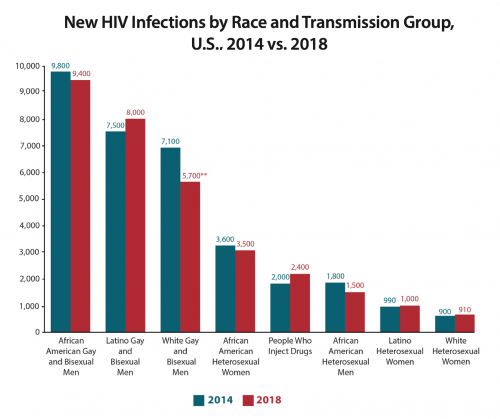The Centers for Disease Control and Prevention (CDC) has estimated that the annual rate of new HIV transmissions held essentially steady in the United States between 2014 and 2018.
An estimated 1.2 million people 13 years old or older were living with HIV at the end of 2018, including 14% who remained undiagnosed. An estimated 36,400 people contracted HIV that year.
Transmission Rates
For the CDC’s new annual HIV Surveillance Report, the agency reviewed data on the CD4 count at diagnosis of people who newly tested positive for HIV between 2014 and 2018, as reported to the National HIV Surveillance System. Such a measure helps researchers estimate when individuals acquired the virus and thus permits estimating year-to-year transmission trends.
All the HIV transmission rates expressed in the report are per 100,000 people. So a rate of 1,000 means that 1,000 out of 100,000 people in the specified group, or 1.0%, contracted the virus in a given year. All the figures are estimates.
In 2018, 36,400 people—a rate of 13.3—contracted HIV. These figures held statistically steady between 2014 and 2018, even though the graph of the yearly estimates indicates that a slight decline began in 2016.

Source: CDC
The transmission rate held steady among both men and women during that period, at a respective 22.1 and 4.8.
The only age group that saw a declining transmission rate was 13- to 24-year-olds. The rate held steady in all other age groups. In 2018, the highest transmission rate was among those 25 to 34 years old, at 31.5, followed by those 35 to 44 years old, at 16.9.

Source: CDC
The only racial group that saw a significant change in the transmission rate was the multiple-race category, in which the rate decreased. In 2018, the highest rate was among Blacks, at 45.4, followed by Latinos, at 22.4, and people of multiple races, at 19.3.

Source: CDC
The transmission rate was stable among all the transmission categories, such as men who have sex with men and people who inject drugs. In 2018, 67% of all new HIV cases and 82% of those among men were transmitted through sex between men. Among women and girls who contracted HIV during that year, 85% did so through heterosexual sex.

Source: CDC
The major U.S. regions all saw a stable HIV transmission rate between 2014 and 2018. During the latter year, the rates were 18.4 in the South, 11.6 in the West, 10.5 in the Northeast and 8.1 in the Midwest.
In 2018, 42% of new HIV transmissions were among African Americans. Sixty-one percent of new cases among Blacks were transmitted through sex between men, and 33% were transmitted through heterosexual sex.
HIV Prevalence
The CDC notes that its estimates for the prevalence of HIV, meaning the number of people living with the virus, for 2018 remain preliminary.
At the end of 2018, 1,173,900 people 13 years old or older were living with HIV, including 161,800 (13.8%) who remained undiagnosed. A total of 428people per 100,000, or 0.428%, were living with HIV in the United States.
The percentage of people living with HIV who were not diagnosed remained steady between 2014 and 2018.
The highest HIV prevalence rate was among African Americans, at 1,434 people per 100,000, or 1.434%. At the end of 2018, 482,900 Blacks were living with HIV, including 67,800 (14.0%) who remained undiagnosed.
At the end of 2018, 679,800 adult and adolescent males were living with HIV that had been transmitted through sex between men, including 107,900 (15.9%) who remained undiagnosed.
To read the CDC report, click here.







Comments
Comments